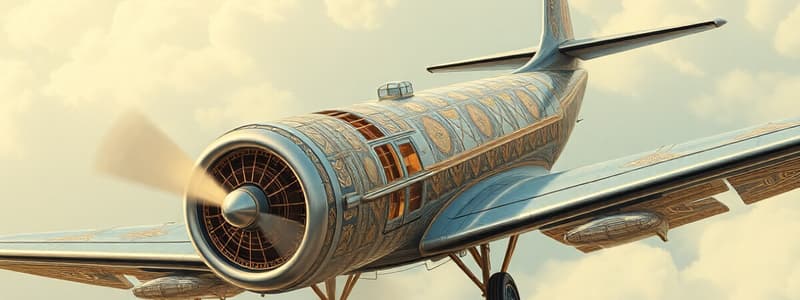Podcast
Questions and Answers
What is the primary responsibility of a flight attendant during an emergency situation?
What is the primary responsibility of a flight attendant during an emergency situation?
- Restocking supplies
- Serving food and beverages
- Ensuring passengers are comfortable
- Instructing passengers on the use of emergency equipment (correct)
Which of the following movements does an aircraft perform when it is climbing?
Which of the following movements does an aircraft perform when it is climbing?
- Ascending vertically (correct)
- Banking to the left
- Yawing to the right
- Pitching downward
In the context of a commercial flight, which equipment is essential for evacuation?
In the context of a commercial flight, which equipment is essential for evacuation?
- Life vests
- Seat belts
- Oxygen masks
- Emergency slides (correct)
What part of the airplane is primarily responsible for lift during flight?
What part of the airplane is primarily responsible for lift during flight?
What is a common term used to describe the procedure for securing passengers' safety at the end of a flight?
What is a common term used to describe the procedure for securing passengers' safety at the end of a flight?
Which of the following actions should a flight attendant prioritize during normal operations?
Which of the following actions should a flight attendant prioritize during normal operations?
What is a key responsibility of a flight attendant when helping passengers in emergencies?
What is a key responsibility of a flight attendant when helping passengers in emergencies?
Which of the following is NOT a standard emergency equipment found on commercial airplanes?
Which of the following is NOT a standard emergency equipment found on commercial airplanes?
Which motion describes an aircraft's change in altitude while moving upwards?
Which motion describes an aircraft's change in altitude while moving upwards?
What is the primary purpose of the emergency exits in an aircraft?
What is the primary purpose of the emergency exits in an aircraft?
Flashcards
Airplane Parts
Airplane Parts
Components of an airplane, like the wings, fuselage, engines, etc.
Airplane Movements
Airplane Movements
Actions an airplane performs, like takeoff, landing, and turns.
TCP Responsibilities
TCP Responsibilities
Duties of a Transportation Control Person (TCP) on an airplane, like safety.
Wh-Questions
Wh-Questions
Signup and view all the flashcards
Emergency Equipment
Emergency Equipment
Signup and view all the flashcards
Takeoff
Takeoff
Signup and view all the flashcards
Landing
Landing
Signup and view all the flashcards
Fuselage
Fuselage
Signup and view all the flashcards
Airplane Parts
Airplane Parts
Signup and view all the flashcards
Flight Movements
Flight Movements
Signup and view all the flashcards
TCP Responsibilities
TCP Responsibilities
Signup and view all the flashcards
Wh-questions
Wh-questions
Signup and view all the flashcards
Emergency Equipment
Emergency Equipment
Signup and view all the flashcards
Takeoff Procedure
Takeoff Procedure
Signup and view all the flashcards
Landing Procedure
Landing Procedure
Signup and view all the flashcards
Fuselage Definition
Fuselage Definition
Signup and view all the flashcards
Study Notes
Airplane Parts
- Fuselage: The main body of the aircraft, enclosing the cockpit, passenger cabin, and cargo hold.
- Wings: Provide lift and control during flight. Key components include the ailerons (for roll), elevators (for pitch), and rudder (for yaw).
- Empennage: The tail assembly, crucial for stability and control. This includes the horizontal stabilizer, elevators, and vertical stabilizer, rudder.
- Landing Gear: Supports the aircraft on the ground. Includes main landing gear, nose gear, and sometimes tail gear.
- Propellers/Turbine: Generate thrust for forward movement.
- Cockpit: The control center of the aircraft, housing instruments and controls for the pilot(s).
- Engine(s): Power source of the aircraft, either piston or turbine.
Aircraft Movements
- Takeoff: The process of the aircraft leaving the ground. Crucial factors include speed, angle, and runway conditions.
- Landing: The process of the aircraft touching down and stopping. Key aspects include speed, descent angle, and the use of flaps for reducing speed.
- Climbing: Gaining altitude after takeoff.
- Descending: Losing altitude before landing.
- Turning: Changing the aircraft's direction, controlled by ailerons and rudder.
- Cruising: Maintaining a constant altitude and speed during a flight.
TCP Responsibilities (with Wh-Questions)
- What are the responsibilities of a TCP (Technician)? Maintaining and repairing aircraft systems, performing pre-flight checks, and troubleshooting issues.
- What safety procedures must a TCP follow? Adhering to all safety regulations and procedures including use of personal protective equipment (PPE).
- Where does a TCP typically work? Both on ground and in aircraft maintenance areas.
- What kind of tools and equipment does a TCP use? Specialized tools for maintenance and repair, varying according to the aircraft type.
- When are pre-flight checks conducted? Before each flight.
- Why is maintaining proper documentation critical for a TCP? To record maintenance procedures, ensuring accountability and safety standards are met.
Emergency Equipment
- Emergency Exits: Located in the cabin, allowing rapid evacuation.
- Life Jackets: Inflatable safety devices for water landings.
- Oxygen Masks: Provide supplemental oxygen in case of cabin depressurization.
- First Aid Kit: Contains necessary medical supplies for minor injuries.
- Fire Extinguishers: Used for putting out fires.
- Emergency Communication System: Use to call for assistance.
- Passive Safety Features: Designed to maximize occupant safety during accidents – including seatbelts, impact-resistant materials, and other structural considerations.
- Location of Equipment: Pilots and crew need to know the exact location for every piece of emergency equipment in the aircraft.
Additional Notes
- Regulations: TCPs must follow strict regulations and procedures dictated by aviation authorities.
- Aircraft Types: Maintenance procedures and responsibilities vary depending on the specific aircraft type.
- Documentation: Detailed records of maintenance tasks are critical.
- Maintenance Schedules: Regular maintenance checks are crucial for aircraft safety.
- Troubleshooting: The ability to diagnose and repair issues quickly and effectively is essential.
Studying That Suits You
Use AI to generate personalized quizzes and flashcards to suit your learning preferences.



